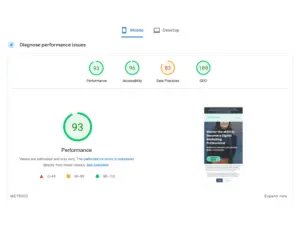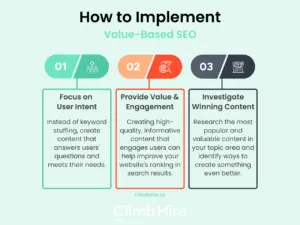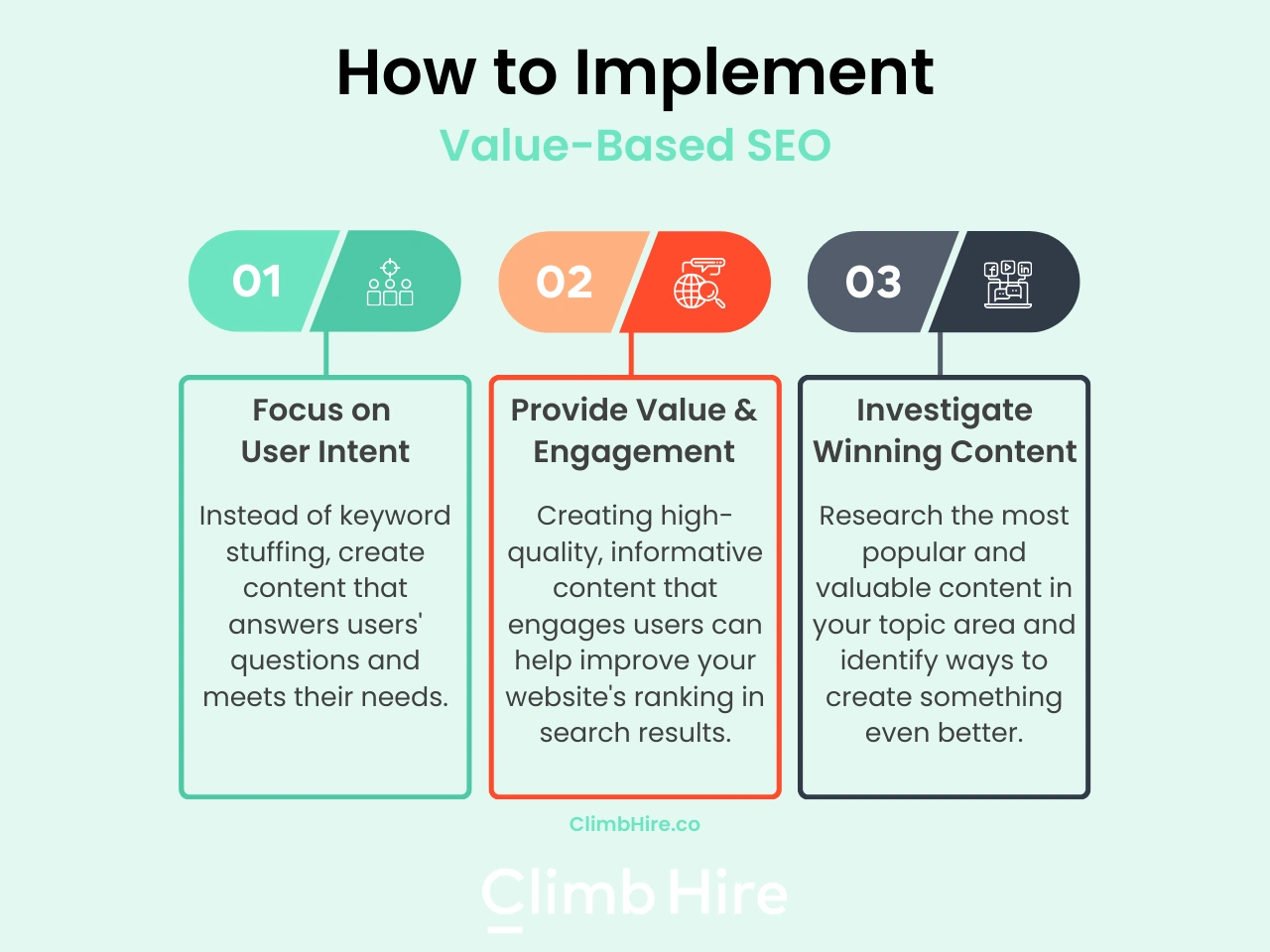Digital marketing is constantly evolving, and it can be tough to keep up with the latest news. From short-form video content to value-based SEO, there’s always something to learn!
At Climb Hire, we understand the importance of staying up-to-date with industry happenings, especially if you’re interested in a digital marketing career. In this post, we’ll explore five current trends and give you a small glimpse of what you can expect when you enroll in our Digital Marketing & E-Commerce program.
Let’s dive in!
-
Short-Form Video Content, Specifically UGC
Short-form video content has been growing in popularity for several years, but it’s exploded in recent months. Platforms like TikTok and Instagram Reels have made it easier than ever for users to create and share short, engaging videos, and brands are taking notice.
Short-form videos are an excellent way for businesses to quickly grab their audience’s attention, effectively convey their message, and increase engagement.
User-generated content (UGC) is a specific type of short-form video content that’s gaining popularity. UGC refers to any content that promotes a brand and is created by consumers. Folks may think UGC only benefits brands with tangible products, but it’s a great option for Software as a Service companies as well – think client testimonial videos about their experiences or a “day in the life” vlog of a customer using your company’s service or attending your theatre’s performance.
Brands are leveraging UGC by reposting this content on their own social media channels, which helps to build brand awareness and trust. TikTok and Instagram Reels are rewarding this type of content by boosting it to reach more people, so being able to utilize UGC when possible is a great strategy to add to your digital marketing mix.
@climbhire Congrats to Braer, cohort 3 alum who has landed a new role at @discord! You rock! #ClimbHire #Upskill #Careerdevelopment ♬ Happy And Playful – 10XMusic -
AI and its Digital Marketing Applications
In digital marketing, it’s all about working smarter, not harder. Artificial intelligence (AI) is one of the most significant trends in tech today and according to Statista, this industry is set to explode in the next few years. Currently valued at around $20 billion, the AI industry is expected to grow by over 200% between now and 2026. For digital marketers, this growth means we can expect to see some pretty sweet benefits.
AI can help businesses better understand their target audience, personalize content, and optimize campaigns. One example of a practical AI use within digital marketing is chatbot technology, which simulates the conversation a customer might have with a company representative. Chatbots are becoming more prevalent, allowing brands to engage with their customers in a more efficient and personalized way. Chatbots can answer customer questions, provide product recommendations, and even make sales.

Chatbot Instructions This type of technology has now expanded to tools like ChatGBT, an advanced language model developed by OpenAI, capable of generating human-like responses to a wide range of prompts and inquiries. While tools like ChatGBT can’t replace the human insights that come from a trained marketer (like providing real-world experience and implementing in-depth marketing campaigns), it can provide you with helpful information related to digital marketing, such as strategies for social media, SEO, content marketing, and email marketing. It can also answer questions you might have about marketing tools and platforms, such as Google Analytics or Facebook Ads.
Above is a real-life ChatGBT response I received after asking about how to add tracking code to Squarespace buttons.
As a digital marketer, one of my current favorite AI tools is Munch.
Munch analyzes your long-form videos and identifies key moments that are most likely to engage social media audiences. It then automatically creates short clips that highlight these moments, with captions and other elements to make them more visually appealing. It’s not perfect, but it’ll save you hours of editing time.
Then there’s programmatic advertising, which uses algorithms to buy and place digital ads, rather than relying on human intervention. This approach allows businesses to optimize their ad spend, target their audience more effectively, and achieve better results. Dynamic creative optimization (DCO) is a programmatic advertising technique that enables advertisers to serve personalized ads to each individual user. DCO utilizes data about a user’s browsing history, behavior, and demographics to serve relevant ad content.

Ad example For example, in Facebook ads, Dynamic Creative Optimization (DCO) allows advertisers to create multiple variations of ad components, such as images, headlines, descriptions, CTAs, and other ad elements, and automatically tests them to identify the best-performing combination for each user.
-
Mobile Optimization
With most internet traffic coming from mobile devices, it’s more important than ever for businesses to optimize their content for mobile. This means ensuring that websites are mobile-friendly and that emails and ads are optimized for smaller screens.
Brands that don’t prioritize mobile optimization risk losing out on potential customers. In fact, some companies employ mobile-first design, which means that mobile devices are the first screens they design for — then they scale up to larger screens.
This approach guarantees that the user experience is optimized for mobile devices, which is where the majority of users access content. Speaking of which, are you reading this on your phone? Let me know how it looks. 😉
Looking for tools to help optimize your users’ mobile experience? Google Search Console (GSC) is a must-have for digital marketers. It provides several resources to ensure your users have the best mobile experience possible:
- Page Experience Report: This report provides insights and actionable recommendations to improve the user experience on mobile devices, including mobile-friendliness.
- Mobile-Friendly Test: GSC still includes a mobile-friendly test that allows you to assess how easily a visitor can use your page on a mobile device.
- Performance Reports: GSC provides performance reports for mobile devices, allowing you to track how well your site is performing on mobile devices compared to desktop devices.
- AMP Reports: If you have implemented Accelerated Mobile Pages (AMP) on your site, GSC provides reports that show how your AMP pages are performing in search results.
Another super useful tool is Google’s PageSpeed Insights, which helps with mobile optimization by analyzing a website’s performance based on key metrics such as load times and visual stability and providing actionable recommendations for improving mobile-friendliness and speed.
Here’s our PageSpeed Insights for Climb Hire’s Digital Marketing & E-Commerce landing page:

-
Live Videos
Live videos have been around for a while, but they continue to grow in popularity. Brands are increasingly using live videos to connect with their audience in a more authentic way. Live videos are a great way to showcase new products, answer customer questions, and provide behind-the-scenes glimpses of a brand.
Actually, on that note… join our upcoming IG Live on Friday, April 28 at 10:00AM to learn more about our Digital Marketing program, hear from Climb Hire alumni, and ask any questions you may have in real time!
Aside from interactive Q&A sessions like the one we’ll be hosting, here are a few other ways you can work live video into your digital marketing strategy:
- Live streaming events: Think webinars, product launches, and conferences (or Coachella’s recent live stream via YouTube). These have become a popular way to engage with audiences in real-time, as they usually feature a live comments section or chat box where viewers can interact with each other and even make purchases.
- Influencer marketing: Brands are partnering with influencers to create live video content that promotes their products or services to the influencer’s followers.
- Behind-the-scenes content: Companies are using live videos to give viewers a behind-the-scenes look at their operations, events, and product development. This is a great way to build transparency and authenticity into your brand, especially as consumers are wanting to engage with inviting and accessible content more than ever.
-
Value-Based SEO
In the past, Search Engine Optimization (SEO) primarily involved using keywords in various places on a website, such as in the page title, meta description, and throughout the content. This technique, known as “keyword stuffing,” was used to manipulate search engines into ranking a website higher in search results. However, search engines have evolved significantly in recent years, and modern SEO now emphasizes meeting user intent and providing valuable, engaging content.
Based on this, here are a few ways to implement value-based SEO in digital marketing:
- Focus on user intent: Instead of keyword stuffing, create content that answers users’ questions and meets their needs. Understanding the specific moments when users turn to their devices to answer a question or solve a problem can help you create content that’s more relevant and useful.
- Provide value and engagement: Creating high-quality, informative content that engages users can help improve your website’s ranking in search results. This means providing valuable information that meets users’ needs and keeps them engaged.
- Investigate winning content: Research the most popular and valuable content in your topic area and identify ways to create something even better. This can help your website stand out in search results and provide more value to users.

How to Implement Value-Based SEO
Learn More With Our Digital Marketing and E-Commerce Track
Like what you learned here?
Implementing digital marketing trends are just a small part of what we cover in our Digital Marketing and E-Commerce Learning Track. Our courses are designed to give you the skills and knowledge you need to succeed in the industry while helping you build a strong professional network.
Digital marketing is here to stay. Don’t miss out on this opportunity to take your career to the next level!

